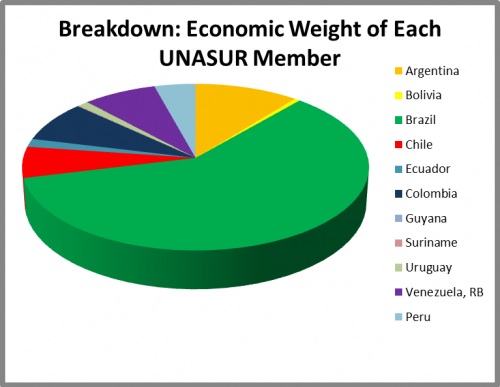The 2013 GDP of member nations was as follows: Colombia -$369.8 billion, Venezuela (2012) $382.42 billion, Chile at $277 billion, $Argentina at $488.2 billion, and Peru at $197.1 billion. This gives the 12-nation, UNASUR group annual earnings of $4.96 trillion. . The problem with the GDP figures is that they include foreign, multi-nationals in the domestic earnings
statistics. Many of these may choose to "fly" the country for safer investments in North America, Europe, and the Far East. This also may hold true of domestic capital depending on tax policies and investor orientation.

Concern for a misleading GDP indicator of wealth has led to the wider use of an economic technique known as PPP or Purchasing Power Parity. PPP is used to determine the relative value of different currencies. This technique uses a consistent store of value to gauge the value of purchases in differing economies for a given item. Currency in one nation may buy more of a
given good than currency in another economy. The PPP was first broached in the 16th century "School of Salamanca". It lay largely unused over the past 500 years, perhaps because as an aggregate measure in comparing economies it must extrapolate values for goods that are not provided in differing countries, and therefore cannot be compared. No two economies have historically
produced exactly the same items for value estimation.
Peru's PPP was $368 billion while GDP was the previously mentioned $197.1 billion. Chile’s GDP was $277 billion while its PPP was measured at $335.2 billion. So there can be wide variance in the measures. A "Gross Real Product" which more accurately measures financial values of domestic goods and services (or even stored) based on foreign and domestic capital within a
nation's borders is highly relevant to the Latin American UNASUR grouping. Equity markets (stock exchanges) tend to be unstable there, as does much of the banking, and "big money" does fly. There are exceptions with Brazil's 3 top banks controlling assets of $172 billion, but investors have to really "know what they're doing" to make a relatively risk-free profit on that
continent, so it really is a case of "Investor beware".
While there probably is a direct developmental link to Europe in this unfortunate socio-economic structure, it is being touted as indigenous with Brazil leading the hemisphere in its deployment. Latin America has routinely viewed the United States as an imperial power, though direct military engagement has been relatively rare and short lived. Economically, South America
has more of a case for American dominance, but the region doesn't have to buy foreign goods. Nationalism easily rallies the masses when there is a perceived injustice, but Cuba is a case where such thinking can prove catastrophic.
The EU has compensated for supply and demand dis-equilibriums associated with cooperation in the market rather than healthy competition, and paid for them with enormous regional debt. This 28-nation alliance is tied, with Germany controlling the European Central Bank from Frankfurt. Now South America is doing much the same, but without the productivity levels or investment
savvy of the more developed nations. Venezuela as a central banker for the alliance presents something of an immediate quandary given its inflation of 56% last year, political unrest, homicides, and street protests. The region doesn't have the financial buffer of Europe, and few would invest there given the high risk of national default. A debt crisis akin to the "Greek"
dilemma would immediately "ripple" throughout the 12 nations, causing immediate ruin rather than the delaying action associated with Germany's largesse in bailing the nation out.
The anti-market movement has proven effective in keeping South America center left. All 12 members except Colombia have such left-leaning, governments, and as of this writing even that country could fall to the wishful thinkers and opportunists in a late May election. Disciplined inter-nation competition, with some "leeway" in tariff and quotas is historically, optimally
productive. By integrating markets socio-economically the hemisphere has insured its demise.
They have until 2019 to decide … so there is still time to decouple UNASUR.